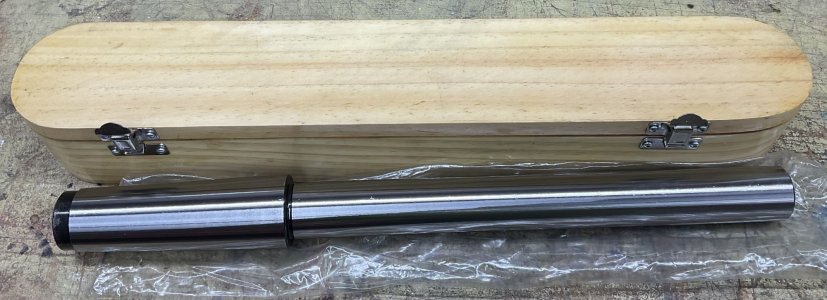In that case you are in real trouble as your bed of the lathe for it would have even more sag in the middle as it is supported at the ends on pivots.
Seriously in terms of deflection, the alignment bar does deflect a small amount, which you can calculate before hand (structural steel handbook has all the formulas, brings back memories in steel building design). Now if the deflection is say 0.000001 per ft (calculated) you consider that as zero. If its less then you head is pointed up, if its more then down.
I would see more influence in errors in a tool in cutting as it applies considerably more forces than gravity in substantially more directions at same time.
I would also add unless you stat looking into temperature if you are getting into this level of precision you are wasting your time as it will effect you readings even more given cast, steel, and a list of other materials used in the lathe.
I see this as chasing rainbows in terms of reading too much into measurements to achieve accuracy. Don't over complicate things.
I think one of us has flawed math.
But, besides the fact that I am prejudiced to prefer my own version, I'll also pick my version simply because you indicated the deflection is linearly proportional to length. ("Now if the deflection is say 0.000001 per ft (calculated)... ").
That is clearly not correct. The deflection is not linear with length.
My math calculates 3 tenths for a 12" bar of average strength (30,000ksi) and a diameter of 1.125" (chosen only for convenience to have a cross sectional area of 1 sq-in to simplify the calc).
For a 16" bar, the calculated deflection is about 1 thou. And for a 2ft bar it is 5 thou.
This compares favorably with the results determined using on-line calculators and other references for Lathe alignment bar deflection I looked at in the past. It is also specifically mentioned in numerous places as the reason for using a shorter bar.
This is also the reason that I am exploring the use of a pipe. A pipe (cylinder) has a much better second moment of area to weight ratio.
Lastly, your comments about how these numbers affect the use of the lathe and alignment of the head suggest maybe we are not on the same page on that subject either.
As others have pointed out, some lathe designs cannot be easily adjusted. Some can be adjusted with great difficulty, and some are just difficult. I've never heard of one that was easy. In my own case, it is just difficult. Mine is done using the six base feet which are used to change the bed twist as well as the head alignment.
For those who have non-adjustable heads, the only purpose of testing the alignment is to know what it is. For the rest of us, it's good to be able to get it as close as practical.
For obvious reasons, a long bar makes it easier to detect small angular differences. But the deflection caused by its own weight works against that.
Your comments about simply taking the deflection into account reflect my own thoughts. If it's negligeable (as it is for short lengths) then as you say, I don't need to worry about it. But since I'd prefer to use a longer bar to magnify the measurement, it probably won't be negligeable. In that case, it must be accounted for.
I don't think accounting for it is as simple as a calculation. Yes, the calculation can get you close, but a measurement can get you bang on. Once you know what it is, I agree with your comments that you can simply adjust your alignment measurements accordingly. Hence my reason for wanting to know what it is...... LOL!
I plan to do some actual measurements in the near future. I'll certainly find out then whose numbers are correct. Those measured numbers will have a profound effect on the final design of my proposed test bar with replaceable collars.
In the meantime, I have ordered an MT5 test bar to use for comparison purposes. And then we will see what we will see about all of this.
I also agree with your comments about the affect of tool pressure. But it's also unknown. So I want to measure it and develop a procedure to accomodate it.
As long as it is stabilized and constant, I don't think temperature is that important for this application. My shop is temperature stable and I always warm my equipment up before any precision work. But that is just an opinion. I have no information or data to suggest otherwise. Nonetheless I am fairly confident that it is much less important than quantifying the weight deflection issue.

